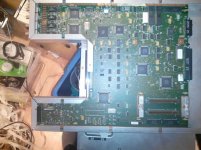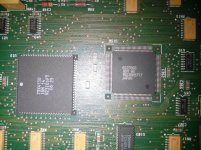As has been alluded to, you appear to have an IBM rack mounted 3490 Tape Drive. The box above it look like the Channel attachment interface. This means that in order to connect it you need a mainframe.
The box on the floor has rightly been ID'd as an IBM 3174 Subsystem Control Unit. If it is one of the later boxes boxes it is a 3174 Establishment Controller - they had potentially more connectivity. The 3174s were "cluster controllers" for groups of 3270 Type A devices: video terminals, printers, PCs etc. Upstream they connected either locally via a S/370 type channel or via one of three remote interfaces: X.21, V.35 or V.24. If your was found with the tape unit, then it is likely to be a channel attached box as well.
Memorex-Telex were a major PCM (Plug Compatible Manufacturer) of IBM 3270 terminals when I was "in the trade". So I guess that they are 3278 clones.
BTW, you'll find my name in the 3174 Red Book because I wrote the original work in 1986 in Raleigh, NC.
BTW2, I love the way that people refer to serial ASCII terminals as "regular". At the time, I reckon that 3270 compatible devices were the "regular" ones - by sheer weight of numbers.


